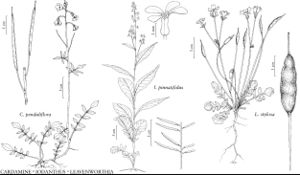Iodanthus
Nomencl. Bot. ed. 2, 1: 812. 1840.
| Taxon | Illustrator ⠉ | |
|---|---|---|
 | Cardamine penduliflora Iodanthus pinnatifidus Leavenworthia stylosa | Yevonn Wilson-Ramsey Barbara Alongi Yevonn Wilson-Ramsey |
Perennials; not scapose; glabrous or sparsely pubescent. Stems erect, branched distally. Leaves basal and cauline; petiolate or sessile; basal (withered by flowering), not rosulate, petiolate, blade margins lobed or not; cauline petiolate (petioles winged) or sessile, blade (base auriculate), margins dentate, entire, or lyrately lobed. Racemes (lax), considerably elongated in fruit. Fruiting pedicels divaricate to ascending, slender or stout. Flowers: sepals erect to ascending, oblong, lateral pair not or slightly saccate basally; petals purple, pink, or white, spatulate, (longer than sepals), claw differentiated from blade; stamens tetradynamous; filaments not dilated basally; anthers linear to narrowly oblong, (apiculate); nectar glands: lateral annular, median glands confluent with lateral. Fruits siliques, sessile or shortly stipitate, linear, smooth, terete; valves each with distinct midvein, glabrous; replum rounded; septum complete; ovules 22–36 per ovary; style distinct; stigma capitate. Seeds uniseriate, plump, not winged, oblong; seed-coat (minutely reticulate), not mucilaginous when wetted; cotyledons accumbent.
Distribution
c, e United States
Discussion
Species 1.
R. C. Rollins (1993) recognized four species in Iodanthus, of which three are endemic to Mexico. As summarized by R. A. Price and I. A. Al-Shehbaz (2001), molecular data clearly support treatment of the genus as monospecific and closely allied to Cardamine, as well as recognition of the three Mexican species as members of Chaunanthus, a genus unrelated to Iodanthus and members of the Thelypodieae.
Selected References
Lower Taxa
"elongated" is not a number."thick" is not a number.